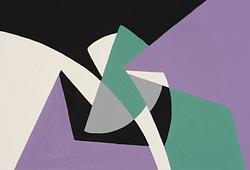Simon Gate
An engraved glass portrait plaque, Orrefors ca. 1935.
Engraved decoration of a man in profile, signed Simon Gate. Diameter 17.7 cm.
Provenance
Andres Laszlo Jr. Collection, purchased in the 1980s.
Literature
Arthur Hald (ed.), "Simon Gate, Edward Hald", The Swedish Society of Crafts and Design, Norstedts, Stockholm 1948, pp. 116-119.
André Laszlo, "Svenskt Konstglas", Sellin & Blomquist Förlag AB, 1991, the plaque illustrated p. 86.
More information
The portrait plaques in glass became a new genre within glass art during the 1930s, where Gate combined his old love for portraiture with his knowledge of glass engraving. It is a series of characteristic models he sketches, featuring a significant number of royals. Erik Wettergren writes about how Gate, through his father-in-law, the court chamberlain Keiller, gets the opportunity to create a portrait of King Gustaf V, which is then engraved on a "king's goblet" and later used by the king as a memento. He also sketches portraits of his friend and patron Prince Eugen, Princess Ingrid, Queen Astrid, and King Leopold of Belgium, as well as other celebrities such as the chairman of the factory's board, Justice Councillor Johannes Hellner, Consul General Josef Sachs, opera singer Gertrud Pålsson-Wettergren, among others.
Who this portrait depicts has not been established. It is exceedingly rare for a portrait plaque of this kind to appear on the market.
Designer
Simon Gate was a Swedish glass artist, painter, and designer. After studying at the Academy of Arts, he started working at the Orrefors glass factory. Together with the glass artist Edward Hald, he contributed to the glass factory's first international success. From 1916, Simon Gate produced the so-called ’graal’ glass, which master blower Knut Bergqvist further developed from cameo glass. Today, the graal glass pieces from Orrefors are among the most sought-after pieces of art glass among Swedish collectors. Together with Knut Bergqvist, he also created the so-called ’slottsglas’ which have received much attention recently. Simon Gate also became famous for his engraving compositions on the glasses, which were decorated with, among other things, processions and dancing women.
Read more







































